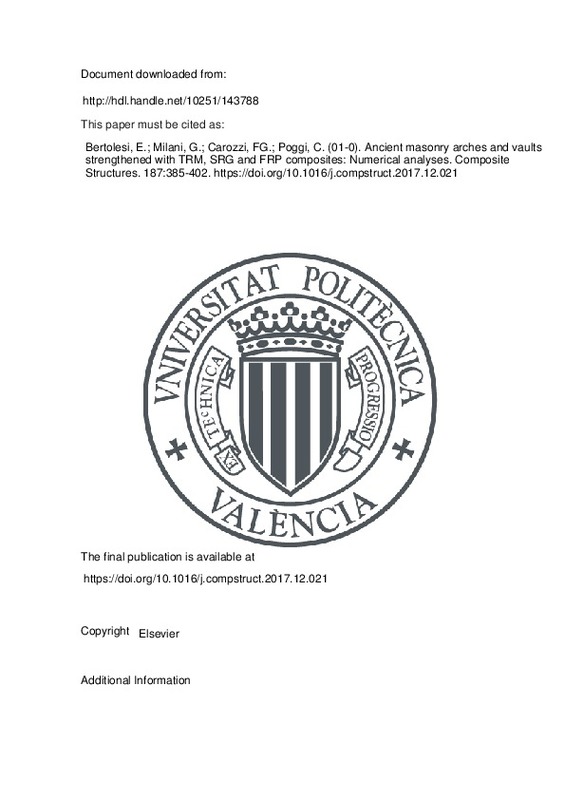JavaScript is disabled for your browser. Some features of this site may not work without it.
Buscar en RiuNet
Listar
Mi cuenta
Estadísticas
Ayuda RiuNet
Admin. UPV
Ancient masonry arches and vaults strengthened with TRM, SRG and FRP composites: Numerical analyses
Mostrar el registro sencillo del ítem
Ficheros en el ítem
| dc.contributor.author | Bertolesi, Elisa
|
es_ES |
| dc.contributor.author | Milani, Gabriele
|
es_ES |
| dc.contributor.author | Carozzi, Francesca Giulia
|
es_ES |
| dc.contributor.author | Poggi, Carlo
|
es_ES |
| dc.date.accessioned | 2020-05-20T03:01:48Z | |
| dc.date.available | 2020-05-20T03:01:48Z | |
| dc.date.issued | 2018-03-01 | es_ES |
| dc.identifier.issn | 0263-8223 | es_ES |
| dc.identifier.uri | http://hdl.handle.net/10251/143788 | |
| dc.description.abstract | [EN] The two arches and the three vaults experimentally described in Carozzi et al. (2017) are here analyzed with a novel robust FE lower bound limit analysis code, suitable to predict active failure mechanisms, lines of thrust and collapse loads in absence and presence of TRM, SRG and FRP reinforcement. The approach relies into a discretization into rigid-infinitely resistant quadrilateral elements for masonry, interfaces between contiguous elements exhibiting limited strength and perfectly bonded rigid-plastic trusses representing the reinforcement. For masonry, a No Tension Material NTM model can be adopted to compare with classic Heyman¿s results, but also a limited compressive and tensile strength with a cohesive frictional behavior in shear may be accounted for in a relatively simple fashion, i.e. in principle with the possibility to model shear sliding and compression crushing. Debonding and delamination of the reinforcement are considered in a conventional way, assuming trusses with a limited tensile strength derived from either experimental data available or consolidated formulas from the literature. With the knowledge of the exact position of the hinges provided by limit analysis, 2D FE static analyses with non-linearity and softening concentrated exclusively on hinges are carried out, to simply extend the knowledge beyond collapse loads estimation towards a prediction of initial stiffness and ultimate displacements. In all cases, promising agreement with experiments is observed. | es_ES |
| dc.description.sponsorship | Part of the analyses were developed within the activities of Rete dei Laboratori Universitari di Ingegneria Sismica - ReLUIS for the research program funded by the Dipartimento di Protezione Civile. | es_ES |
| dc.language | Inglés | es_ES |
| dc.publisher | Elsevier | es_ES |
| dc.relation.ispartof | Composite Structures | es_ES |
| dc.rights | Reconocimiento - No comercial - Sin obra derivada (by-nc-nd) | es_ES |
| dc.subject | Masonry | es_ES |
| dc.subject | Arches and vaults | es_ES |
| dc.subject | Textile Reinforced Mortar TRM | es_ES |
| dc.subject | Fiber Reinforced Polymer FRP | es_ES |
| dc.subject | Steel Reinforced Grout SRG | es_ES |
| dc.subject | Numerical modelling | es_ES |
| dc.subject | LOwer BOund Limit Analysis (LOBOLA) | es_ES |
| dc.title | Ancient masonry arches and vaults strengthened with TRM, SRG and FRP composites: Numerical analyses | es_ES |
| dc.type | Artículo | es_ES |
| dc.identifier.doi | 10.1016/j.compstruct.2017.12.021 | es_ES |
| dc.rights.accessRights | Abierto | es_ES |
| dc.description.bibliographicCitation | Bertolesi, E.; Milani, G.; Carozzi, FG.; Poggi, C. (2018). Ancient masonry arches and vaults strengthened with TRM, SRG and FRP composites: Numerical analyses. Composite Structures. 187:385-402. https://doi.org/10.1016/j.compstruct.2017.12.021 | es_ES |
| dc.description.accrualMethod | S | es_ES |
| dc.relation.publisherversion | https://doi.org/10.1016/j.compstruct.2017.12.021 | es_ES |
| dc.description.upvformatpinicio | 385 | es_ES |
| dc.description.upvformatpfin | 402 | es_ES |
| dc.type.version | info:eu-repo/semantics/publishedVersion | es_ES |
| dc.description.volume | 187 | es_ES |
| dc.relation.pasarela | S\357065 | es_ES |
| dc.contributor.funder | Dipartimento della Protezione Civile | es_ES |







![[Cerrado]](/themes/UPV/images/candado.png)

